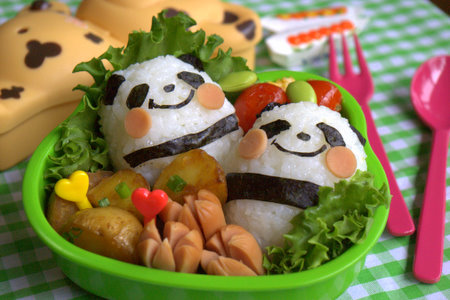
Something always on the minds of parents is nutrition. You want to make sure your kids are getting all of the nutrients they need, but it’s not always clear what that entails. New nutritional guidelines help by suggesting portion sizes and diet styles, but even if you can apply these at home, you can’t always guarantee your kids will be getting the same nutrition and education at school. Schools do their best to provide a healthy lunch, but children don’t always make the best choices when the decision making is left up to them. When visiting my nieces’ elementary school for lunch, I always see trash cans filled with fruits and vegetables, and the kids sitting at the lunch tables delving into the less desirable options. Despite teachers monitoring students during lunch, it’s difficult to actually enforce healthy eating and discourage wastefulness.
While living and working as an English teacher in Japan, I was able to learn about how the school lunch system works there, and how important food education is considered. The Japanese tend to eat a healthy and balanced diet, and they take their food education seriously. They want to instill healthy habits from a young age, so that their citizens can have a long and healthy life. It must be working, because the Japanese have the longest life expectancy in the world.
One of my adult students in Japan was a nutritionist working for the local government, and it was her job to plan meals for the public schools and to regularly go into classrooms to teach about nutrition. While teaching nutrition in the classroom is not uncommon in most developed world elementary schools, Japanese elementary schools are especially unique in their food education in regards to their lunch program. They don’t have dedicated cafeterias, and they don’t employ lunch servers; they eat in their classrooms and students are the servers. Each day, a few students are chosen for lunch duty and they go to the kitchens to pick up the food and serving trays and bring them back to the classroom. Unlike American cafeterias where students typically get to choose from 3 entrees and then self-serve from a salad bar, Japanese students are all served the same things. With no options, students have no choice but to eat what is provided for them, or not eat at all. While perhaps rough for picky eaters at first, students encourage one another to try new foods. This is particularly easy in Japan, as social pressure to not stand out makes complaining about the provided food undesirable. The meals provided for the students are always nutritious and diverse, and children learn to like trying new foods and eating healthy.
If you feel like your young children are too picky and aren’t eating as nutritiously as you would like, you can try to apply some Japanese tactics to your own household. You can learn about the components of a typical Japanese meal and utilize them in your own home cooking. While they don’t necessarily need to be actual Japanese dishes, I do encourage you to try some Japanese food recipes! There are so many more dishes from Japan besides Sushi and Ramen. Though, whether or not you decide to use Japanese recipes in your cooking, the most important thing to do is to not give your children any other options than what is currently for dinner. I know it’s tempting to give in to their protests and demands for different food, but after a few rough and hungry days, they will eventually give in to trying new foods. Your kids will not starve themselves for long. Encourage them to try a little bit of everything, and assure them that they don’t have to like everything they try.
A fun way to incorporate Japanese tactics and food into your children’s diet at school is through bento. Bentos are Japanese home lunches with a variety of different foods in one lunch box that focus on nutritional balance. If you are worried your children aren’t making the best decisions with school lunch, send them a lunch from home balanced and fun. There are so many fun and delicious bento ideas out there to get some inspiration from, or you can invent your own! I wholeheartedly recommend adding rice balls to your kids’ bento lunches. They are great at filling up your kids, and can be made with a variety of fillings. You can even trick your kid into eating roasted seaweed. Cut it into fun shapes and stick it on the rice ball under the disguise of “green paper you can eat” and watch your kids eat something (probably) completely out of the ordinary for them. I did this with my nieces, and it worked like a charm.
Japanese children are some of the healthiest and least picky children in the developed world, and you can help your children become the same way. Through food education and applying some Japanese thought and tactics to your household, you can encourage your kids to have nutritious and varied eating habits as well.



























